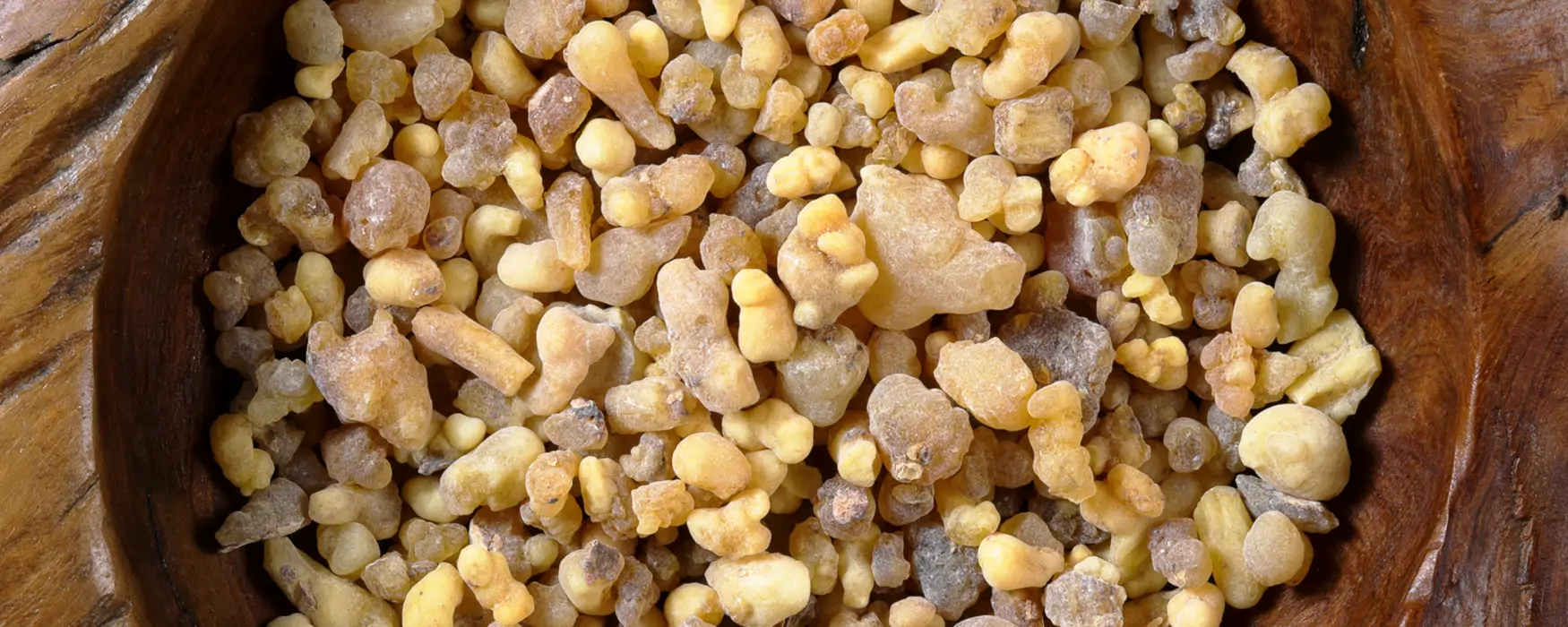
Frankincense is a prized resin harvested from the Boswellia carterii tree that primarily thrives in Somalia’s arid landscapes, where it has shaped both local life and global trade for thousands of years.[1] Somalians chew it for oral health and blend it with milk or honey as a traditional tonic and pre-Islamic tribes once burned it in animist rites to honor their ancestors.[6, 10] In this expansive article, we cover a wide range of topics, from its extensive history to conservation concerns.
1. Botanical Description
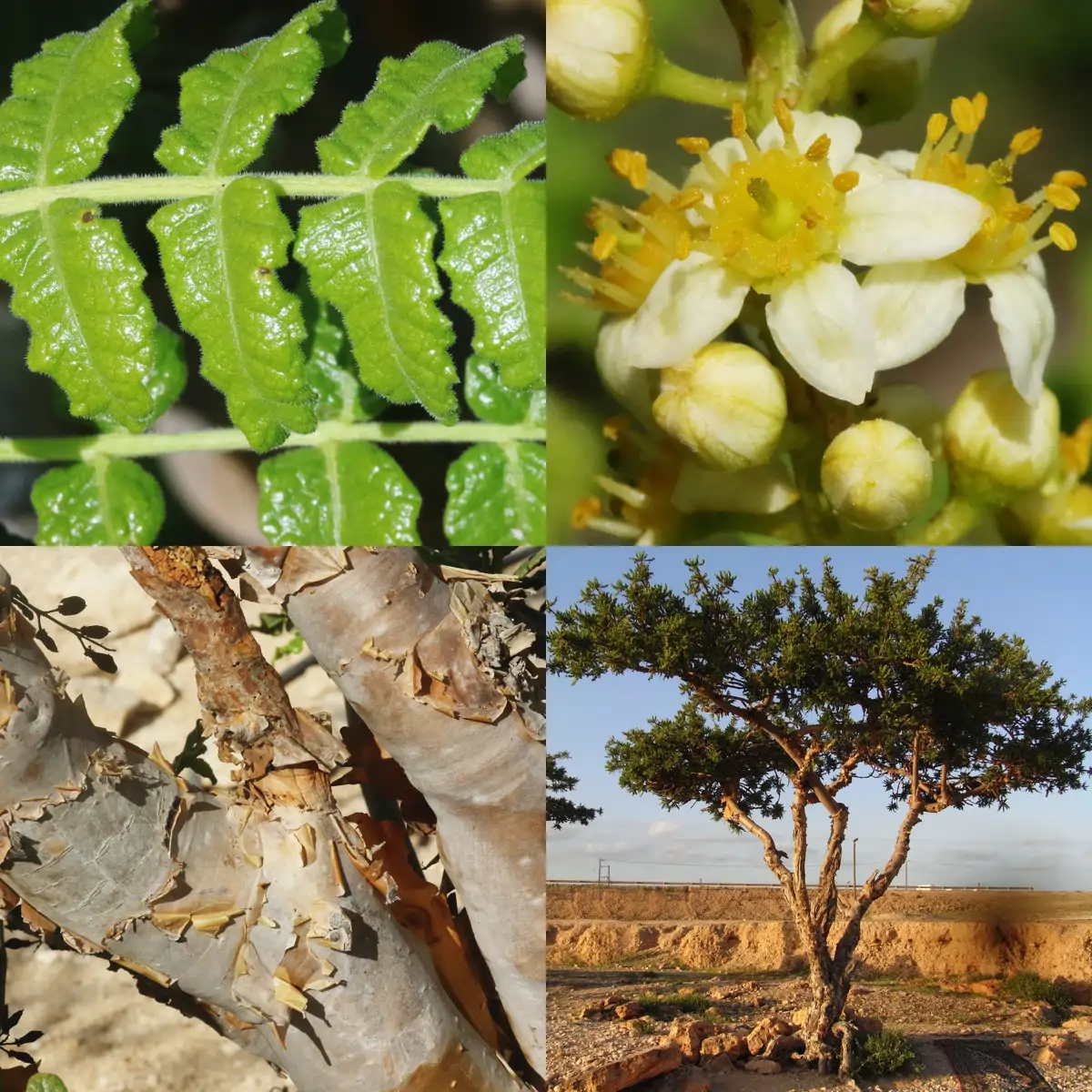
Boswellia carterii, a species within the Burseraceae family, is native to East Africa, particularly Somalia, and parts of the Arabian Peninsula. This small tree, reaching 2–8 meters in height, features papery, peeling bark and compound leaves with 7–15 opposite leaflets. It produces small, yellow-white flowers in axillary clusters and a 1 cm capsule fruit. Adapted to arid, rocky terrains up to 1,200 meters elevation, it favors calcareous soils. [1] Though historically conflated with Boswellia sacra, differences in essential oil properties indicate they are likely distinct species or ecotypes.[4]
2. Frankincense Resin Production
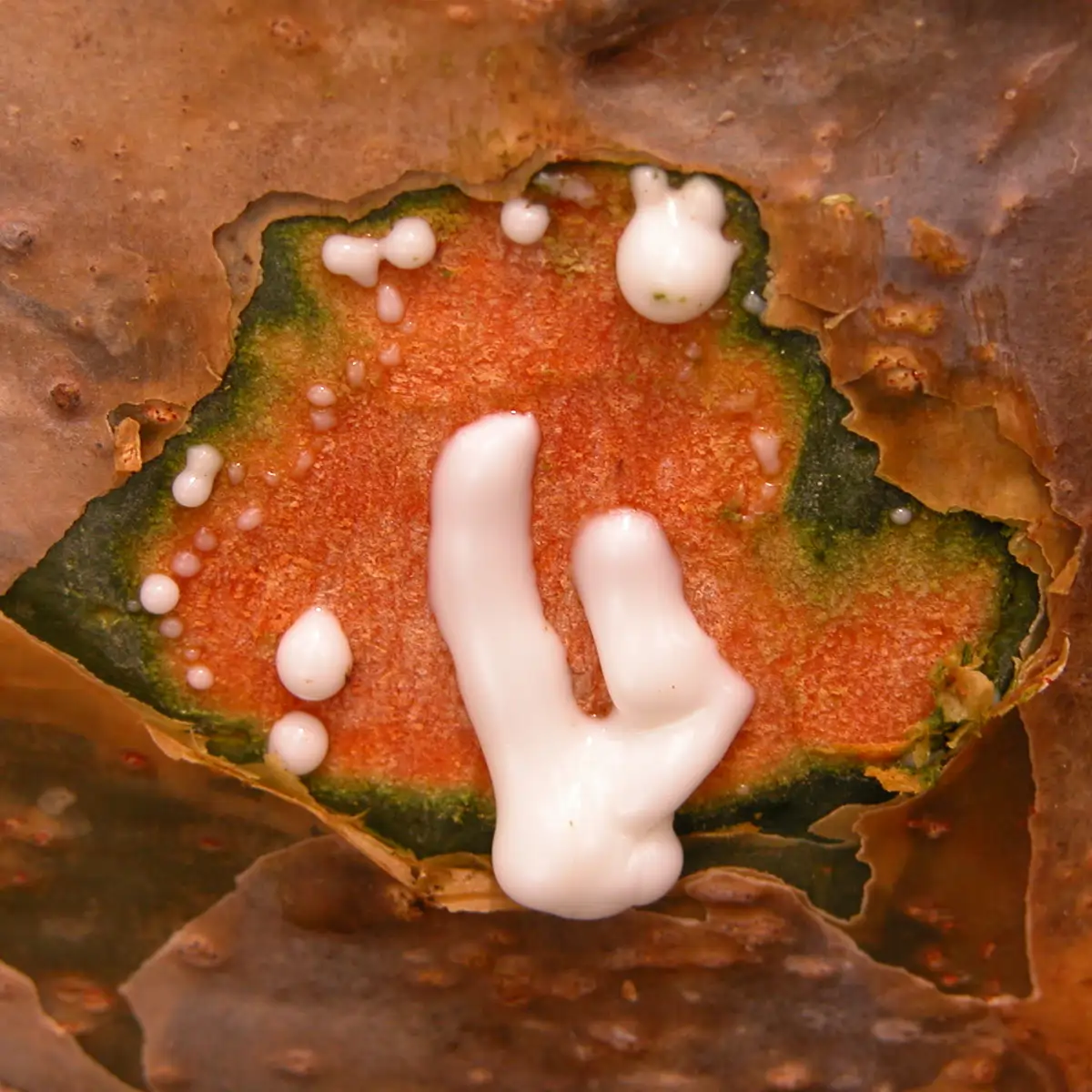
Frankincense, the aromatic resin of Boswellia carterii, is harvested by making shallow incisions into the tree’s bark, typically in Somalia’s dry season from February to May. This cut releases a milky white sap that flows for several hours before hardening into orange-brown tears over 10–14 days, after which harvesters scrape the solidified resin from the trunk. In Somalia, skilled graders (often women) grade the yield, with the clearest, whitest tears labeled “Hojari” a material prized for both traditional and modern uses.[4]
3. Frankincense Perfume
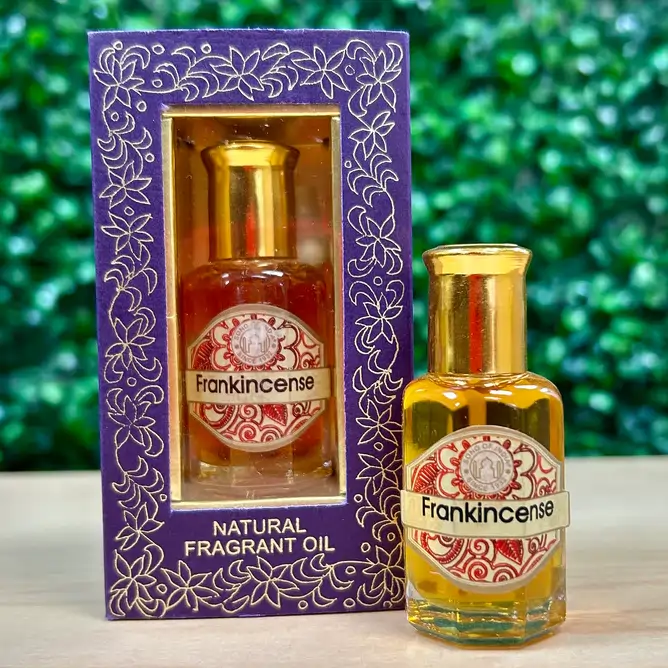
In perfumery, B. carterii essential oil provides a warm, resinous base note with balsamic and woody tones. It serves as a fixative, stabilizing volatile top notes in fragrances by brands like Creed or Amouage. Boswellia carterii essential oil is steam-distilled to yield a cleaner, less smoky scent than the raw resin. Frequently blended with sandalwood for a richer, longer-lasting fragrance, it has become a sought-after ingredient in natural perfumery.[7, 8]
4. Medicinal Uses and Benefits
Boswellia carterii has been valued for its medicinal properties for approximately 5,000 years, with applications spanning traditional remedies and modern research.[6]
Traditional Uses
In Chinese medicine, the resin has long treated arthritis, dysmenorrhea, and trauma-related pain; in Middle Eastern cultures, it is used to help heal wounds.[1]
Modern Uses and Benefits
Contemporary research validates and expands its therapeutic potential, revealing the following applications and effects:
- Reduces inflammation and swelling, notably in arthritis treatment.[2]
- Enhances insulin production and lowers blood sugar, aiding diabetes management.[4]
- Exhibits cytotoxicity against cancer cells (e.g., bladder tumors), showing preliminary anti-cancer potential.[6]
- Combats fungi and bacteria while neutralizing free radicals, leveraging its essential oil’s antimicrobial and antioxidant properties.[5]
Side Effects and Safety
Extracts up to 1,000 mg/day for 6 months are generally safe, with rare reports of nausea or diarrhea.[3] It may increase bleeding risk with anticoagulants or affect liver-processed drugs; safety during pregnancy remains unestablished.[6]
5. How to Burn Frankincense Resin for Incense
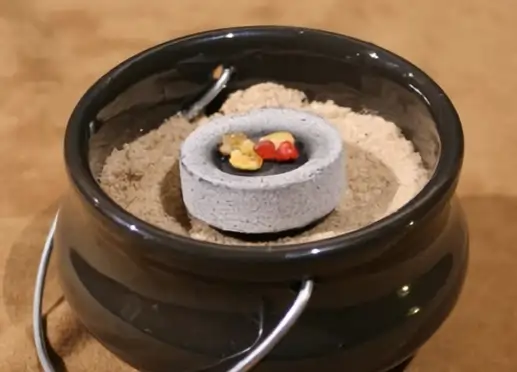
Burning Boswellia carteri resin as incense can be accomplished using traditional charcoal or modern electric heaters, each offering distinct methods for releasing its aroma.[9]
Using Charcoal:
- Light a charcoal disc for 20–30 seconds until it glows, then set it in a heat-resistant burner lined with sand or ash for insulation.
- Wait 1–2 minutes until the charcoal is fully covered with ash.
- Place a pea-sized piece of resin on the disc; it will melt and release aromatic smoke.[9] Avoid leaving it on too long, as overheating can burn the fragrance-free components, diminishing the scent.[9]
- High-quality resin, such as Somali Hojari, produces less residue for a cleaner burn.[9] However, it is very expensive.
Using Electric Incense Burners:
- Alternatively, an electric incense burner set to 200–250°C can vaporize the resin with less smoke and offer more time to remove the resin shortly after the scent has been released.[9]
6. Ecological and Conservation Concerns
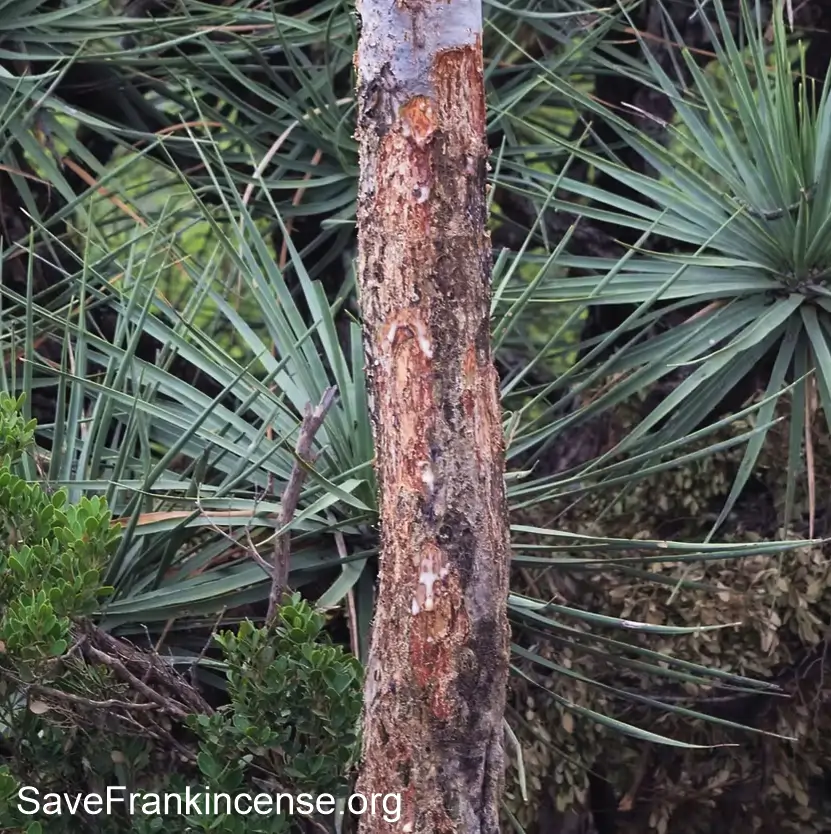
Boswellia carterii faces significant threats from overharvesting and climate change, notably prolonged droughts that reduce soil moisture critical for its survival.[10] Excessive tapping—often every 3 months rather than a sustainable 6-month interval—exacerbates tree stress by limiting recovery time, contributing to a potential 30% population decline by 2040 and earning the species a “near threatened” designation.[10] In Somalia, efforts to counter these risks include cooperatives enforcing extended rest periods between harvests and organizations like Savefrankincense.org that certify sustainable practices to protect both the species and local livelihoods.[10, 15]
7. Economic and Trade Insights
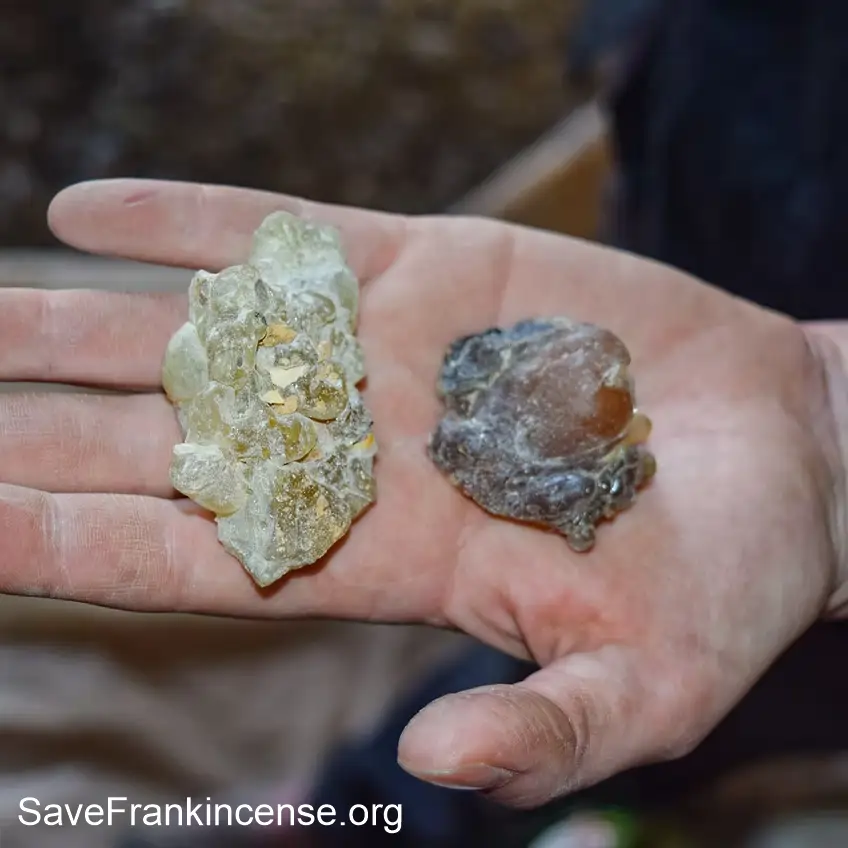
Somalia, a primary exporter of Boswellia carterii resin, ships approximately 1,000 tons annually, generating an estimated $10–15 million in revenue that sustains thousands of rural harvesters [10]. The resin, traded globally to markets in Europe, Asia, and the Middle East for perfumery and incense, faces growing adulteration with cheaper pine resin or synthetic substitutes, often detectable by their sharper scents or discovered by laboratory volatile analysis.[7] This practice, affecting up to 20% of lower-grade frankincense, undermines market trust and depresses prices for authentic resin, challenging Somalia’s economic stability.[7, 10]
8. Frankincense’s Role in History
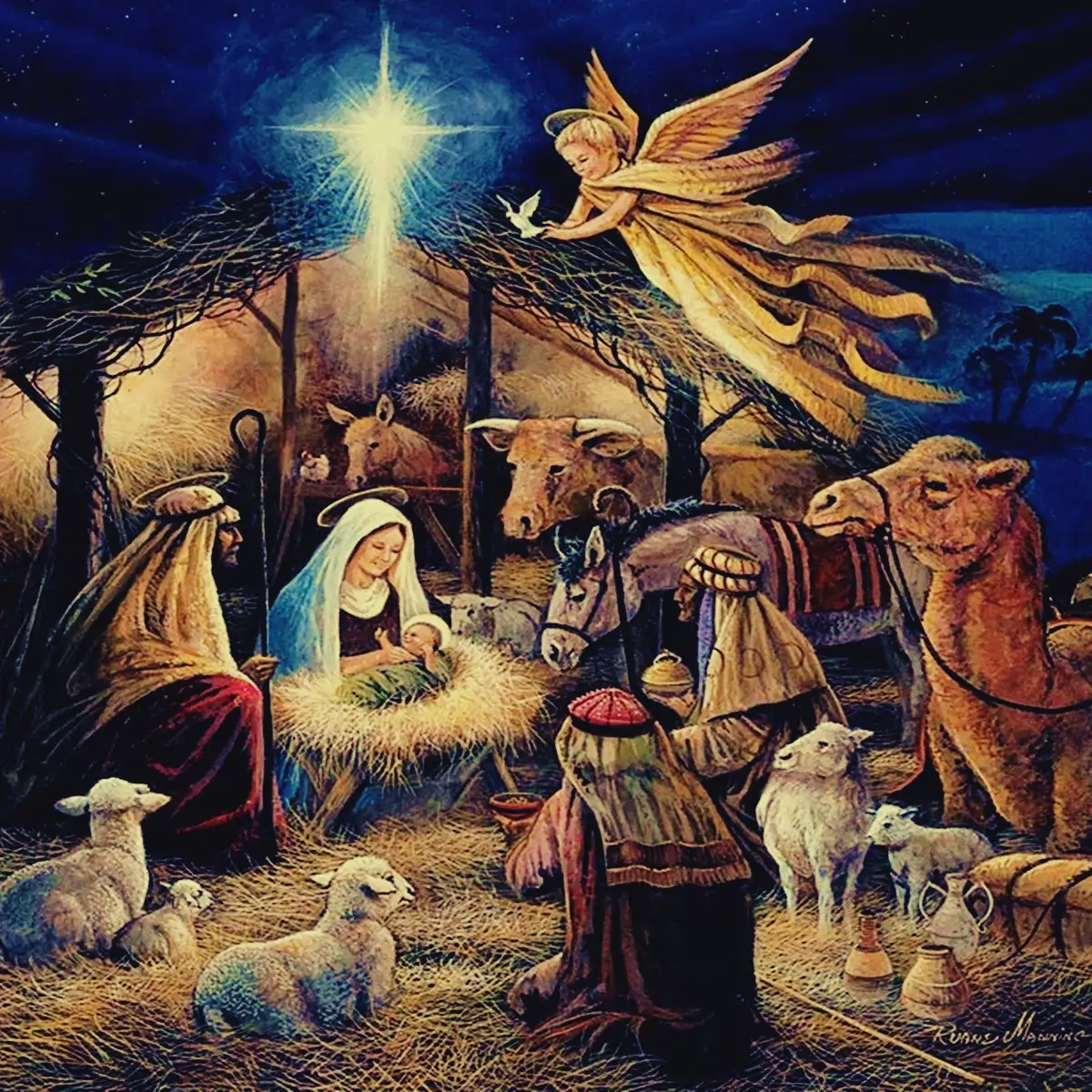
Frankincense uncovered at archaeological sites across Egypt, Syria, and Oman highlights Boswellia carterii’s vital role in ancient trade and ritual.[1] In Egypt, the 1922 excavation of Tutankhamun’s (King Tut’s) tomb from 1323 BCE revealed alabaster jars holding about 50 grams of Boswellia resin, from Somali trade networks, used for embalming and sacred offerings.[1] Farther east, the 2002 unearthing of Qatna’s royal tombs in Syria, dated to the 18th to 14th centuries BCE, found incense burners with roughly 10 grams of frankincense, confirmed by gas chromatography-mass spectrometry as Boswellian imported from Punt for ceremonies.[11] In Oman, excavations at Sumhuram Port from the 3rd century BCE to the 5th century CE uncovered storage pits with around 2 kilograms of resin, likely from Somali routes, bound for Roman markets along the Incense Route.[12] Frankincense has been used in religious ceremonies for over 5,000 years. Egyptian priests burned it to honor their gods, and the wise men from the East, known as the Magi, presented it as a gift to baby Jesus over 2,000 years ago.[1] Termed luban in Arabic, it remains a cornerstone of Middle Eastern and Christian rituals.[6] Churches burn it in censers during Mass throughout the year and at special services for Christmas and Easter, filling sanctuaries with its warm, woody scent for worship and reflection. In Somalia, people burned it to drive out evil spirits in early rites, a practice that flowed into Christian use by the 4th century. In early aromatherapy, healers relied on its balsamic, citrusy aroma to calm rituals; now, people heat it in burners to reduce stress and improve focus.
9. Frankincense Comparison
A comparison of the four most common types of Frankincense based on chemical composition, sent profile and primary uses to assist in finding the right Frankincense for the right application.[13]
Chemical Composition:
- B. carterii (Somalia): Contains α-pinene (37%), limonene (19.8%), and p-cymene (6.3%), with a negative optical rotation (-13.3°, a measure of light-bending properties) and boswellic acids (compounds reducing swelling), supporting its medicinal potential.[2]
- B. sacra (Oman): Rich in α-pinene (68.2%) and limonene (6.2%), with a positive rotation (+30.1°), emphasizing monoterpenes that enhance its aromatic intensity.[4]
- B. frereana (Somalia): Features α-phellandrene dimer (20.2%) and α-pinene (12.4%), with minimal boswellic acids, prioritizing fragrance over therapeutic compounds.13]
- B. papyrifera (Ethiopia): Dominated by octyl acetate (57–65%) and n-octanol (3–8%), yielding a distinct chemical profile.[13]
Scent Profile:
- B. carterii: Warm, balsamic, and versatile, with woody-citrus undertones, suitable for diverse aromatic applications.
- B. sacra: Woody and spicy, with a sharp, resinous edge, ideal for intense incense experiences.
- B. frereana: Fresh and pine-like, with a clean, less smoky finish, favored in subtle fragrances.
- B. papyrifera: Sweet and fruity, less resinous, offering a softer aromatic character.
Primary Uses:
- B. carterii: Medicinal applications (see Section 5), perfumes and incense.[2, 7]
- B. sacra: Predominantly used for high-quality incense in religious ceremonies (e.g., Omani Hojari grade).[4]
- B. frereana: Primarily employed in perfumery and skincare.[7]
- B. papyrifera: Common in Ethiopian incense, used as a chewing resin, and in regional culinary and rituals.[13]
10. DIY Recipes using Frankincense
Here are a couple of Frankincense recipes, please feel free to share your own in the comments section.
Soothing Balm (Makes ~2 oz):
Melt 2 tbsp beeswax and 4 tbsp coconut oil (double boiler, 150–170°F), cool to 120°F, add 10 drops Frankincense oil, 5 drops lavender. Pour into a tin; solidify (2–3 hours). If it hardens too fast, reheat gently.[14] Apply to sore joints or dry skin.
Massage Oil (Makes ~1 oz):
Mix 1 oz jojoba oil, 8 drops Frankincense oil, 4 drops sandalwood in a dark bottle. Shake well.[14] Use for muscle relaxation; store in a cool, dark place.
Incense Powder (Makes ~2 tsp):
Grind 1 tsp Frankincense resin, 1 tsp sandalwood powder, ½ tsp myrrh. Sprinkle a pinch on charcoal [9]. If smoke is too thick, reduce resin amount. Burn for meditation.
Safety:
Dilute oils to 1–2%, patch-test, avoid ingestion, consult a doctor if pregnant [3]. Visual suggestion: Photos of finished balm, oil bottle, and incense setup.
Conclusion
Frankincense gathered from the Boswellia carterii tree has a history of use dating back thousands of years and, when procured in its unadulterated form, is a high-quality incense, perfume and natural supplement. Just like the rest of you, we are interested in learning more about it. Please feel free to comment if you would like to add to this conversation or would like to comment on something in this article.
Sources
- Boswellia sacra – Wikipedia
- Boswellia carterii Extract Inhibits TH1 Cytokines – PMC
- Boswellia: Uses, Dosage, Side Effects – Healthline
- Frankincense Overview – ScienceDirect
- Boswellia Essential Oil: Natural Antioxidant as an Effective Antimicrobial and Anti-Inflammatory Agent – MDPI
- Boswellia Purported Benefits, Side Effects & More – Memorial Sloan Kettering Cancer Center
- Olibanum (Frankincense) – Fragrantica
- Essential Oils Market – Market Research Reports
- Step-by-step guide: How to burn frankincense resin at home – Pink Jinn
- Conservation Assessment and Chemistry of Boswellia ogadensis, a Critically Endangered Frankincense Tree – National Library of Medicine
- Analysis of frankincense in archaeological samples by gas chromatography-mass spectrometry – National Library of Medicine
- Land of Frankincense Reports – UNESCO
- Analysis of frankincense from various Boswellia species – National Library of Medicine
- Aromatherapy: A Complete Guide to the Healing Art – Book by Kathi Keville and Mindy Green
- Protecting the Frankincense Economy and Ecosystem – SaveFrankincense.org
